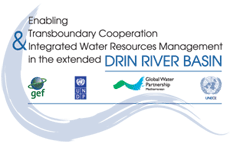Transboundary Monitoring
Read the Guidelines for Monitoring Strategies in Transboundary Aquifers here 
Read the final report for the Design of a multipurpose transboundary groundwater monitoring network here 
Structured monitoring strategies are paramount to achieving sustainable groundwater resources management and meeting environmental goals. In the case of transboundary aquifer management, structured approaches are necessary in order to facilitate agreement on joint monitoring strategies among the involved countries; once in place, these strategies can enhance trust and cooperation for the management of transboundary water resources.
The Webinar “Monitoring Strategies in Transboundary Aquifers: Goals, Methods and Tools - The case study of Skadar/Shkoder – Buna/Bojana Delta transboundary alluvial aquifer”, conducted in the frame of the GEF Drin project, analyses existing groundwater monitoring strategies, tools and methods for transboundary aquifers and provides guidelines on how to design monitoring plans compliant with EU Water Framework Directive (WFD) regulations and national frameworks. It also provided specific guidelines for the operation of a monitoring network in the particular two-hydrogeology context (coastal area and inland alluvial aquifer) as applied in the Global Environment Facility Drin project.
Read the webinars' Agenda and Concept Note.
| Agenda Item | Presentation / Video |
|
Introduction: Welcoming remarks • Alice Aureli, Chief of Groundwater System and Human Settlements Section, UNESCO IHP • Vangelis Constantianos, Regional Coordinator, GWP-Med • Neno Kukuric, Director, IGRAC |
|
|
Session 1: Why monitoring is paramount to address appropriate groundwater resources management and to attain EU WFD environmental goals? The specific case of transboundary aquifers. • Dr. Josep Mas Pla |
|
|
Session 2: The hydrogeological conceptual model as an initial step towards design of a monitoring network. Data requirements, basic issues (including pressures, impacts, vulnerability and risks) to be considered. • Dr. Laura del Val Alonso |
Download
Watch |
|
Session 3: Where must monitoring wells be located? Identifying and selecting the most representative spots in coastal aquifers and inland aquifers. • Dr. Josep Mas Pla |
Download
Watch |
|
Session 4: How to monitor groundwater levels? Instrumentation and practical considerations. Interpretation and reporting hydraulic head data. • Dr. Laura del Val Alonso |
Download
Watch |
|
Session 5: How to monitor groundwater quality? Groundwater sampling techniques and practical considerations. Interpretation and reporting hydrochemical data. • Dr. Josep Mas Pla |
Download
Watch |
|
Session 6: Data management: Considerations on data processing, storage, quality assurance and reporting. Sharing databases in transboundary aquifer monitoring programs. • Dr. Laura del Val Alonso |
|
|
Summary: Proposal of a feasible monitoring plan based for a transboundary aquifer on the EU WFD regulations applied to the DRIN project. • Dr. Josep Mas Pla |
Download
|
|
Plenary Discussion: Questions and Answers Moderators: • Alexandros Makarigakis, Dr Josep Mas Pla, Dr Laura Alonso |
|
|
Closing remarks • Alexandros Makarigakis, Groundwater System and Human Settlements Section, UNESCO IHP • Dimitris Faloutsos, Deputy Regional Coordinator, GWP-Med / Drin Project Manager |
The workshop was organised by the United Nations Educational, Scientific and Cultural Organization (UNESCO), in partnership with the Global Water Partnership – Mediterranean (GWP-Med).





